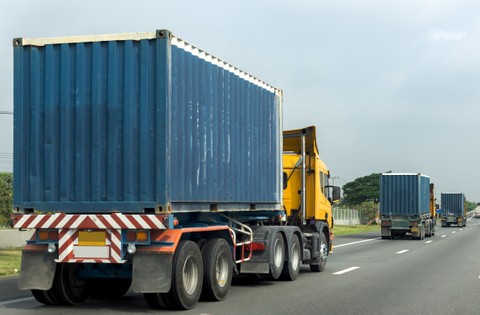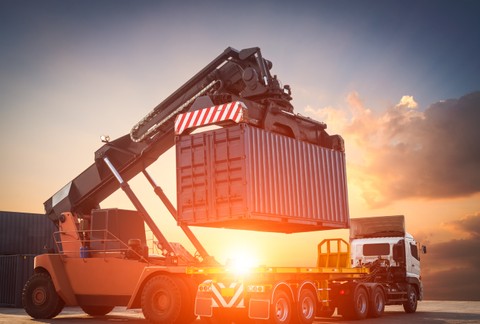We're Here to Help
Most Frequently Asked Questions
Just have a couple of questions?
Call Us at 1-877-697-7223

How do I get a standard 40-foot, or 20-foot shipping or storage container moved?
Loaded or empty, how do you move a container? There are a couple different ways that are available depending on your specific circumstances. Loaded containers can be a complicated process that if done wrong can result in financial disaster. So how do they move these shipping containers? There are multiple different methods, landolls, sideloaders, tilt-beds, and standard flatbed/step-decks. If you have an empty container, using a simple tilt-bed or a landoll would be the most cost-effective option. Some landolls might not be able to move loaded storage containers, you’ll want to check with us if there is one in your area that can. Using a container to move across the country? Anticipate cranes to load and offload your container and a flatbed to transport it. The “one and done” trucks do not travel long distances, so there needs to be a way to pick up the container off the ground and subsequently put it down on the ground at the destination. Click here to learn more.

How do you transport a shipping container without a crane?
The most effective way to move a container without a crane or forklift is by using a tilted bed trailer, such as a Landoll, or a sidelifter. Some landolls might not be able to move loaded containers, you’ll want to check with us if there is one in your area that can. You will need to ensure that there is enough space around the container for either of these two options.

What kind of trailer is needed to transport a shipping container?
The most common trailer used to transport and deliver a container is a standard container chassis. These are primarily found transporting cargo in and out of ports and can be a little hard to come by outside of that area. Landoll’s are common, some can winch up to 35,000lbs. Sidelifters can level lift and transport loaded containers most efficiently without tilting the container. Tilt-bed trailers and drop deck trucks primarily move empty 20’s.

How heavy is a shipping container?
Typically, an empty 20-foot shipping or storage container weighs between 3,970 - 4,850lbs and an empty 40-foot shipping container weighs 8,340 - 9,260lbs depending on what kind of container it is. But your container will tell you about the exact weight on the door.

What if I don’t know the weight of my container?
If you’re unsure of the weight of your loaded container, we’ll talk it over with you and get photos of the inside to get an idea of the contents inside and what their weight might be. At the end of the day though, the items inside are yours and it’s your judgement we use. Ideally, you’ll load the container with the weight in mind. But if you did not do this, we may need to overestimate the weight to ensure that we don’t run into issues loading the container or sending out a truck that is too small.

How to move a storage container by yourself?
There isn’t really a good way to move a storage container yourself unless you have the actual equipment designed to move them. If your container is stuck in a tight spot, using chains to pull it out with a truck could potentially be an option. You pose a serious risk of damaging your vehicle or yard, but in a bid to save on costs it could be an option. Outside of that, moving a container by yourself without a trailer or chassis is impossible.

Can I use a shipping container to move residentially or commercially?
Absolutely! If you don’t already own a shipping container, we can get you in touch with the right people to purchase one. Using a Conex for moving allows you the freedom and flexibility to load the storage container at your leisure. Planning for a move can be stressful, at Container Movers we try to take the stress out of moving and plan for all contingencies. We’d be more than happy to answer any questions you may have over the phone (877-697-7223); our team are experts when it comes to containers and how to move them.

Can I rent a shipping or storage container to move residentially or commercially?
You could, but it might not make the most economical sense. We do not offer purchase options or rentals so the rental would need to be through a 3rd party. Most companies will not allow their container to be transported to another location by another company so you will want to verify that it is an option. Another thing to keep in mind, wherever you rent the storage container from will need to be returned to that same location. And in most instances, the cost will be almost as much as the initial trip.
How much does it cost to transport or move a container?
Moving a container is usually a multi-step process, so there are a lot of factors to consider when getting an idea on pricing. Click here to learn more.

How Do I Arrange for Container Delivery or to Move a Shipping Container?
Through us, of course! We’re the experts at moving containers and have the strongest network of carriers in the country that move them. We realize there might be a lot of questions you might have, and even questions you might not know to ask. Do I need a crane? Is a Swinglift or sideloader an option? How should I load my shipping container? How do I accurately estimate the weight of my Conex? Are there any container movers near me? Give us a call, even if you’re not sure where your container will end up, we can help inform you on the process.

Is Nationwide Container Trucking and Delivery Available?
Yes, our services cover nationwide delivery. We are a shipping container moving company that ensures every corner of the country can access our container transport services, although some remote areas may have logistical challenges.

Do I Need Planning Permission for Container Placement?
Shipping containers are typically considered temporary relocatable buildings. In most cases, they don't require planning permission. However, it's advisable to check with local authorities, especially for long-term placements or in sensitive areas.

What Is the Typical Delivery Time for a Shipping Container?
The average delivery time varies based on distance. If it’s a local move expect it to be delivered the same day or next day. If you’re moving coast to coast, it could be up to 5-7 days. We’ll always inform you of what the expected delivery day and time will be and will keep you appraised of any changes that may arise.

Are There Any Restrictions on Container Delivery Locations?
Yes, there are certain restrictions. For example, container moving companies need to ensure the delivery site is accessible, free from obstructions like overhead cables, and has a suitable surface for container placement. Before we schedule, we’ll work with you to confirm your delivery site is accessible. We’ll request photos of the site and will ask various questions about the property, and if needed we’ll arrange a local crane company to do a site walk of the site to ensure there aren’t any restrictions with the site.

How Are Shipping Containers Affected by Condensation, and How Is It Managed
Metal surfaces like those of shipping containers can experience condensation due to temperature variations. However, modern containers are designed to minimize this, such as having corrugated constructions and slightly bowed roofs. If you plan to place your container on grass or dirt, consider putting railroad ties underneath it to keep it off the ground. Ground conditions can affect your storage container and if you live in an area that experiences rain or snow- keeping it off the ground can prevent it rusting and causing damage to the goods inside. If your storage container isn’t wind and weather tight and shows signs of rust, consider lining the container on the inside with a tarp to prevent any moisture from getting in.

What Maintenance Do Shipping Containers Require?
Shipping containers require minimal maintenance. New containers need very little upkeep, while used ones may need occasional oiling of door hinges, repainting of dented or corroded areas, and patching if necessary.

How Secure Are Shipping Containers?
Shipping containers are designed to be highly secure, with robust locking mechanisms. For enhanced security, additional locks or steel hasps can be fitted to protect against unauthorized access.

How should I load my container when preparing for a move?
The most important thing to keep in mind when loading your container is keeping the weight as even as possible throughout the container. One side should not be drastically different in weight compared to the other side. This is incredibly dangerous and can damage equipment and delay the shipment. The heaviest items should lie flat and in the middle of the container, this will require planning, but it will ensure a safe trip for your container and belongings.

I’m moving overseas- Can I call Container Movers to assist?
Shipping overseas is not an easy feat and requires the assistance of a Freight Forwarder or NVOCC. These agencies book ocean transport and can sometimes assist with getting a container to the rail or port. If you’re working with one already and they ask that you arrange drayage directly into the port or rail we can assist, but the actual shipment of the container on a vessel would require the assistance of an NVOCC or Freight Forwarder.

